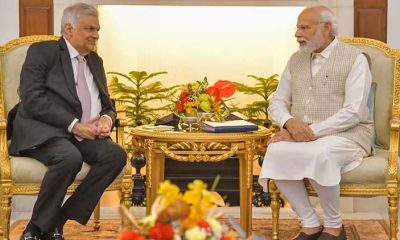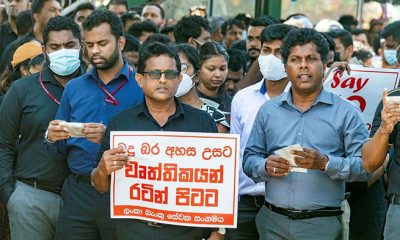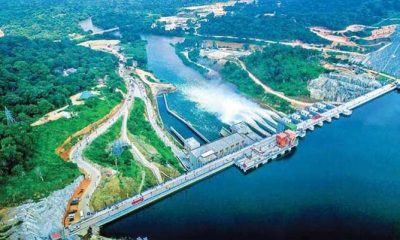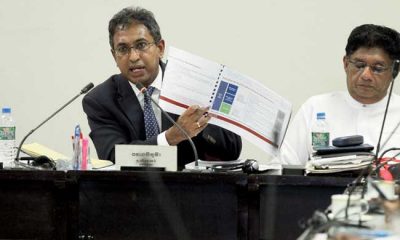Features
Experimenting with State-Owned Enterprises

by Neville Ladduwahetty
The total number of Sri Lanka’s State-Owned Enterprises (SOEs) is reported to be 527. Of these, 55 are categorized as strategically important. According to Public Finance Data and Analysis, only 11 out of 52 SOEs have Published Financial Data up to 2022. Consequently, except for the common knowledge that the overwhelming majority of SOEs are loss making institutions, no one has a clue as to the extent of the cumulative losses incurred, nor the number employed by the SOEs.
Against this background, the public has raised concern about the privatization of the SOEs, especially the strategically important ones. The government has appointed Suresh Shah as the Head of State-Owned Enterprises Restructuring Unit (SOERU) to review and address issues relating to SOEs.
During a seminar held at the Organization of Professional Associations (OPA), Shah reportedly said: ‘To ensure transparency and effective management, the draft legislation is based on nine guiding principles stipulated in the Cabinet-approved SOE reform policy, covering board appointments, policies, financial aspects and others. Around 85 SOEs have been identified as commercial entities, out of 138 considered’.
What happens to the rest? According to Shah ‘A key highlight of the upcoming legislation is to bring SOEs under a Holding Company (HoCo) which would drive comprehensive reforms of state enterprises, the management and governance of state enterprises, and state’s portfolio of enterprises. The proposed HoCo is modelled after Singapore’s Temasek. However, it would take time and effort for this entity to evolve into modern day Temasek’ (Mirror Business, February 02, 2024).
HISTORY of Sri LANKA’s SOEs
Since Independence, the public has heard ad nauseam, words such as “transparency and effective management”. Some include “accountability” as well. The fact that the draft legislation is based on “nine guiding principles” is no assurance that the HoCo would be free to live by them without interference of one kind or another. Before addressing reforms, it is necessary to understand WHY SOEs are in the state they are in today.
SOEs are used as vehicles to practise unabated nepotism that permits the appointment of the kith and kin of politicians to the Boards of SOEs and to give employment to political loyalists for favours done during elections. Consequently, most SOEs are compelled to carry the baggage of incompetent managers who are clueless to manage a bloated workforce. It is this reality that makes SOEs loss-making institutions from the very outset. Even profit making SOEs have to cater to the behest of their political masters.
For instance, SriLankan Airlines, which was a profitable institution under an effective management, began to incur losses after the removal of key personnel because they opted to cater to the obligations of their customers in preference to the convenience of those who appointed them. Similarly, the Chairman of SLT, who ran that institution profitably, was removed, without any explanation, and a new board appointed. A request was made to them to withdraw the case they had filed against the proposed merger between Dialog Axiata and Airtel. The refusal to oblige resulted in the board being asked to resign. A new board has now been appointed.
This is the culture in which the HoCo with its ‘nine guiding principles stipulated in the Cabinet approved SOE reform policy’ would have to operate. It is a far cry from the culture in Singapore, where Temasek operates. Does the fact that only around 85 have been identified as commercial entities mean that the remaining 442, out of the total of 527 SOEs, are allowed to hang out to dry as loss-making entities because the prospect of their survival under the HoCo is remote.
Therefore, instead of limiting the scope to SOEs with commercial value, a serious attempt should be made by the SOERU to develop a strategy to make the SOEs a collective mix of profitable and loss-making entities for the service they provide so that taken as a collective, SOEs are not a burden to the State. Instead of such an approach, the objective of the SOERU appears to be to identify those that could be attractive to the private sector because of their commercial value.
In this regard, policies adopted by the private actor could go beyond the limits of commercial valuations, to others, such as Security. For instance, the attempt to sell the government’s share in Sri Lanka Telecom to either of the two shortlisted companies of Indian and Chinese origins may not only have foreign policy implications but also cause security concerns as well.
PROPOSED REFORMS for SOEs
In addition to the intended reforms proposed by SOERU at the OPA seminar, the Secretary to the Ministry of Finance has said that one of the key legislations the government is working on relates to the SOE reform Bill. What is interesting is that both the Secretary and the SOERU representative emphasised the importance of transparent procedures in the selection of Members to the Boards of SOEs. While it is indeed heartening to hear the importance given to transparency in selecting Board Members with the right credentials, history tells us that however right the credentials are, there is no guarantee that the policies they opt for would turn out to be relevant to meet the ever-changing challenges.
Instances of this kind of mismatch abound. We have had individuals with outstanding credentials in economics who advocated lowering taxes and printing money with consequences, the likes of which Sri Lanka had not experienced. Perhaps, their policies may have been right under different circumstances, but they certainly did not prove right for the economic circumstances Sri Lanka was in when they were proposed. There were others who advocated banning the import of chemical fertiliser and replacing it with compost.
They did not realise that the high yield seed paddy that was used by the farmers not only increased their incomes but also enabled the State to feed the nation which depended on the use of chemical fertiliser. Furthermore, a fact recognised by agricultural research scientists is that high yield seed paddy is not compatible with compost because of low yields. Another is the instance where a highly placed bureaucrat advocated the import of urea because it was cheaper than producing it locally, and called for the dismantling and selling the urea plant. Soon afterwards, the sale prices of imported urea increased.
PROPOSED STRATEGY
The lesson to be learnt from the few experiences cited above is that while it is important to select the right Members for the Boards of SOEs, it is equally or even more important that they adopt the right policies. Since the reason for the failure of most SOEs is fundamentally one of poor or bad management resulting from the reasons cited above, it is absolutely vital that each SOE operates under agreed guidelines that are monitored regularly by the Oversight Committees of Parliament. Furthermore, since policies need to change with changing circumstances and challenges, structural arrangements that permit regular reviews are an absolute necessity.
The following procedures are recommended to ensure that each of the 527 SOEs function and perform under the close scrutiny of Parliament:
* NO SOE should be privatised, whether they have commercial value or not. 85 of the SOEs with commercial value are invariably located on prime land. Privatising such SOEs would tempt investors to sell such lands and gain healthy returns with no regard to the contributions made to the state from their operations and the personnel employed by them.
* Each SOE should be assigned to a particular Oversight Committee of Parliament.
* Each Oversight Committee should call upon SOEs assigned to them to submit a comprehensive Policy Statement with the participation of the workforce outlining the strategies they plan to adopt to realise their objectives.
* These policy statements should be reviewed by each Oversight Committee, with the assistance of experts in the related fields, and a mutually acceptable consensus reached with each SOE, which then would become the Operating Guidelines for each SOE.
· The performance of each SOE should be reviewed by the respective Oversight Committee at regular intervals to evaluate performance and accountability.
CONCLUSION
It is reported that the government appointed State-Owner Enterprises Restructuring Unit (SOERU) is preparing legislation to address issues relating to the existing 527 SOEs. In the meantime, the Ministry of Finance is also engaged in a State-owned enterprises reform Bill. This combined effort to reform SOEs is because over the years they have become a serious financial liability to the State.
According to the SOERU, of the 138 SOEs considered, 85 have been identified as commercial entities and plans are for 17 to be formally wound down. Presumably, out of the 527 total SOEs and the 85 identified as commercial entities, the remaining 442 SOEs (less the 17 to be wound down) would have to function under forthcoming legislation that includes a Holding Company (HoCo) that would be modelled after Singapore’s Temasek, notwithstanding the cultural and historical disparity that exists between the two countries.
The need to reform SOEs so that they could be made to function as financially viable entities and in the process for them to make a positive contribution towards serving the interests of the State and provide gainful employment to thousands is long overdue. However, if the intended reforms are to have a positive impact, the reformers should acknowledge that the reason for the dire state of most SOEs today is because they have been made dysfunctional by the practices adopted by successive governments.
Judging from the sketchy media reports, the focus of the reforms appears to be on ‘transparent mechanisms to appoint board members to SOEs and put an end to the current tradition of political appointments’. Even if reforms ensure that appointments to the boards of SOEs are free of politics, it is a combination of effective boards backed by sound policies that make institutions viable and effective. Therefore, the drafts of policies developed by boards should be vetted by the workforce since the success of policies depends on their commitment to the implementation of the policy.
The draft policies developed by each SOE should be reviewed by the Parliamentary Oversight Committee and consensus reached so that such policies become the Operating Guidelines against which each SOE is regularly assessed in respect of its operations. Since policies are not static, regular reviews by Oversight Committees would enable policies to be modified to meet ever changing challenges.
What is of concern is the government’s intent to privatise most of the 85 SOEs that have commercial value regardless of whether they are profit-making or not. Since most of the SOEs are located on prime State Lands, privatising them would mean transferring state assets to private companies. Such an outcome may even amount to winding down some SOEs to the detriment of those currently employed.
The need to privatise key SOEs has arisen because successive governments have made them loss-making or less effective by resorting to practices in violation of “immutable republican principles of REPRESENTATIVE DEMOCRACY”. This makes it obligatory for the incumbent government to honour their pledge to the people and seek their approval at a referendum before disposing of assets.
Features
Tree planting along road reservations and banks of streams

Reservations of Roads & Natural Streams which extend to about 10 to 20 on either side are not actively protected in Sri Lanka though it is very common in other countries. Those reservations are owned by the government. Therefore, public use of this land can be considered as a fair use of the land. Main purpose of this proposal is to introduce an intervention to connect the Forest Patches in urban areas such as Gampaha using the reservations of roads and natural streams, by planting trees so that those strips could also act as Urban Bio Corridors while enhancing the tree cover at national level. These trees also absorb the fumes emitted by vehicles while addressing global warming caused due to lack of tree cover. It also serves as a roof top for pedestrians who use reservations along public roads while adding aesthetic value to the area. Enhancing the community awareness about BioDiversity of Sri Lanka and the importance of maintaining a clean environment along road reservations is also another objective of this type of intervention. This intervention also addresses the needs of all sectors of the local communities.
Concept
The Green Road is a relatively new concept for roadway design that integrates transportation functionality and ecological sustainability. This project addresses the transport sector also because it facilitates Environmentally Sustainable Transport (EST) for local people. Therefore, Provincial Road Development Authority (PRDA) is the ideal institute to implement this project. It is also possible to introduce cycle tracks along stream banks as short cuts by improving the banks of natural streams as roads. This intervention would reduce vehicle congestion in main public roads while supporting Clean Sri Lanka programme because local communities themselves become watch dogs against culprits who pollute road reservations and water bodies of natural streams.
Already implemented projects in Mahaweli Areas
In Sri Lanka, the concept of Bio Corridor was introduced in 1988 under a Project called Mahaweli Agriculture and Rural Development project implemented in System B under an USAID funded programme. Similar to highways which connect main cities, in this case the Bio Corridors were introduced as “Bio Highways” connecting fragmented forest patches (“Bio Cities”) in paddy field areas. At the same time those corridors were improved as Cycle Tracks for the local farmers.
Figure 1 indicates the present status of a tree plantation programme implemented in Mahaweli Area (Thambuttegama) in the 1980s along newly introduced roads.
Past Experience of PRDA (WP) related to similar interventions
In 2010, similar intervention was introduced in Gampaha District in parallel with a flood mitigation project implemented by the Provincial Road Development Authority (WP). For example, while Uruwal Oya running adjacent to Gampaha Urban Area was improved to mitigate floods, riparian tree belt areas were also introduced. Later, parts of that stream running adjacent to Gampaha Town were improved as Recreational purposes such as jogging tracks for urban communities. As an additional benefit, it was expected that the shades provided by riparian tree cover would discourage growth of invasive plants such as Japan Jabara, which clogs the drainage outlets resulting in floods in urban areas.
by Eng. Mahinda Panapitiya
Features
Has Compass lost direction?

Sri Lankan voters have excelled in the art of changing governments in executioner style, which they did in many elections including that of 1977,1994, 2015, 2019 and, of course, 2024. They did so, giving massive majorities to parties in opposition that had only a few seats, because the preceding governments were so unpopular. It invariably was a negative vote, not a positive vote-endorsing policies, if any, of the incoming governments, the last election being no exception. NPP, contesting under the compass symbol, was essentially a revamp of the JVP and their main strategy, devoid of any specific policies, was throwing mud at opponents and promising a transparent, corruption free government. They made numerous promises on the hoof. Have they stood up to the challenges?
What the vast majority of the public wanted was a significant reduction in the cost of living, which has spiralled out of control due to the misdeeds of the many preceding regimes, resulting in near starvation for many. The NPP promised to renegotiate the deal with the IMF to give relief to the masses but soon found, to their dismay, that it was a non-starter. Of course, the supporters portrayed it as a display of pragmatism! They promised that the price of fuel could be slashed overnight as it was jacked up by the commission earned by the previous minister who was accused of earning over Rs 100 for every litre! It has not happened and the previous minister has not received the apology he deserves. The cost of living remains unbearable and all that the government continues to do effectively is slinging mud at opponents.
To the credit of the NPP government, financial corruption has not set in, but it cannot be forgotten that most previous governments, too, started this way, corruption setting in later in the cycle of government. However, corruption in other forms persist contrary to the promises made. Had the government sacked the former speaker, the moment he could not justify the claimed PhD, it could have claimed high ground and demonstrated that it would not tolerate corruption in any form. For some reason, unknown to the public, he seems to have a strong hold on the party and he seems indispensable!
As for bringing to justice those previously corrupt, only baby steps have been taken. During the election campaigns AKD promised to get Arjun Mahendran from Singapore within 24 hours of his election and now they are blaming the Singapore government! It looks as if promises were made without any idea as to the practicality of implementation. According to social media posts circulated, the list of assets held by Rajapaksas would have made them richer than Elon Musk! A lady lawyer who described in detail, during the election campaign, the wealth amassed in Uganda by Rajapaksas admitted, after her election, that there was no basis. Her justification was that the NPP government ensured free speech; even to tell lies as the truth.” Government media spokesman has just admitted that she lied about the cost of new year text messages sent by previous presidents and she remains an ‘honourable’ MP!
As far as transparency is concerned, Compass is directionless. MoUs/Pacts signed with India, during the recent visit of PM Modi shines bright with opaqueness! After giving various excuses previously, including that those interested could obtain details by making requests under the Right to Information Act, the official cabinet spokesman’s latest is that it needs the permission of India to release details. This makes one wonder whether there is a lot to hide or it may be that, de facto, we are already under the central government of India and that AKD is just the Chief Minister of the 29th state!
Whilst accusing the predecessors of misuse of power, the NPP does the same thing. AKD’s statements that he would be scrutinizing allocation of funds to local bodies, if opposition parties are elected, surely is an indirect threat to voters. Perhaps, it is not an election offence as the Elections Commission has not taken any action despite complaints!
Whether the exposition of the Tooth Relic, which was done in a mighty hurry, to coincide with the mini-election campaign would backfire remains to be seen. As it was done in a hurry, there was no proper planning and even the basic amenities were not provided to the thousands who queued for days. AKD, as usual, was quick with a political gesture by the unplanned visit meeting those in the queue. What he and his government should have done is proper planning but, instead, government supporters are inundating social media blaming the public for bad behaviour!
To cap this all is the biggest faux pas of all; naming the mastermind of the Easter Sunday attack. AKD built up expectations, and the nation was waiting for the exposure on 21 April, which never materialised. His acolytes are doling out excuses. Dr Nalinda Jayatissa was as evasive as possible during his post-cabinet meeting briefing. Perhaps, there is no mastermind other than those identified by all previous investigations including that by the FBI. All that the president did was handing over the Presidential Commission of Inquiry report to the CID. The acting IGP appointed a committee of three to study, but the next day a fourth person was added, a person who is named as one of those who did not act on intelligence received!
Perhaps, as an attempt to give credence to the allegations made in the Channel 4 programme, Pillayan was arrested. Though it was on a different offence, the alleged abduction of the former chancellor of the Eastern University, Minister Wijepala had the audacity to state in the parliament otherwise. Pillayan has been detained under the PTA, which the NPP promised to abolish! The worst is the campaign of character assassination of Udaya Gammanpila who has decided to represent Pillayan. Dr Jayatissa, who has never practised his profession, took exception that Gammanpila, who has not practiced as a lawyer, is representing Pillayan. Gammanpila has corrected him by listing the cases he had been involved in. In any case, Gammanpila need not be in court but get a set of lawyers to defend, if and when, a case is filed. It begs clarification, the ministerial comment that Gammanpila should be ashamed to represent Pillayan! Has the government already decided the guilt of Pillayan?
Compass has lost direction, indeed, and far too soon!
By Dr Upul Wijayawardhana
Features
Canada holds its own as Americans sour on Trump

On Monday, April 28, Canadians gave the Liberal Party its fourth successive mandate, albeit as another Minority Government but much stronger than in the last two elections, and, more importantly, with a different Prime Minister. Justin Trudeau who had been Prime Minister from 2015 was forced to resign in January 2025 on account of his perceived electoral unpopularity. Trudeau was succeeded by Marc Carney, 60 year old former Governor of the Bank of Canada and later the Bank of England, who dramatically revived the falling fortunes of the Liberal Party and secured its fourth mandate in 10 years.
The Liberal Party and Prime Minister Mark Carney owe their good fortunes to the presidential madness that is going on south of the border, in the United States of America. With his mercurial obsession over tariff’s and recurrent musings about making Canada America’s 51st State, President Trump painted the backdrop to the Canadian election. Trump’s antics did not go down well with the Canadian public and in a rare burst of patriotism the people of Canada overarched their diversities of geography, language, culture, religion and ethnicity, and rallied round the Maple Leaf national flag with utmost determination to stick it to Trump and other Ugly Americans of his ilk.
People and businesses in Canada shunned American products, stopped travelling to US holiday destinations and even took to booing the US national anthem at sporting events involving US and Canadian teams. The threat of economic pain due to a tariff war is real, but Canadians are daring to suffer pain rather than become a part of the US. And Justin Trudeau showed his best leadership in his last days as Prime Minister. Combining diplomatic skill and splendid teamwork with eloquent defiance, Trudeau succeeded in forcing Trump into what has since become Trump’s modus operandi in implementing his idiosyncratic tariff policy: tariff, one day; pause, the next day; and uncertainty, extended indefinitely.
100 Days of Disaster
What he began with Canada and Mexico, Trump has since writ large upon the whole world. His second term is already a term of chaos not only for America but also for the whole world economy. The US economy is officially in first quarter contraction. Another four months, it could be a man made recession of what was in January an economy that was humming sound and was easily the best performing one in the world. It’s only 100 days of the second term, and what is left of it is looming as eternity. “Only 1,361 Days to Go,” is the cover page heading of the latest issue of the Economist. That sums up America’s current state of affairs and their global spillover effects.
Americans are beginning to sour on Trump but there is no way for them to channel their frustrations and anger to force an immediate executive retreat. Trump has reduced the Republican Party to be his personal poodle and with Republics holding slender majorities in both the Congress and the Senate, the Legislative Branch of the US is now wholly beholden its Executive. The traditional wait is for the midterm Congress elections in two years. But Trump has no respect for traditions and conventions, and it would be two years too much before a Democratic majority in the two houses could bestir the Congress to check and balance the runway president.
The Judicial Branch is now playing catch up after the Supreme Court had given Trump near absolute immunity and enabled his second coming. The lower courts are applying the law as they should and stymieing Trump’s palpably illegal orders on everything from deporting immigrants, to downsizing government, and gutting the country’s university system. The tariff cases are slowly making their way to courts and they will add more confusion to the running of the economy before some kind of sanity is restored. Overall, by upending a system of government that has been constitutionally evolving over 200 years, Trump is providing a negatively sobering demonstration that no system is foolproof if a capable fool is elected to take over the reins of government.
Fortunately for the world, other governments and polities have been quick in drawing the right lessons from the demonstration effects of Trump on their American cousins. Trump’s excesses have had a dampening effect on right wing populism in other countries. The Canadian elections are one such demonstration. Another is expected in Australia where national elections are scheduled for Saturday, May 3. In Europe, right wing populist parties are scaling down their rhetoric to avoid facing local backlashes to Trump’s American excesses.
No populist leader anywhere wants to go where Trump is blindly heading, and no one is mad enough like him to think that imposing tariffs is the way to grow a national economy. In Hungary, its strongman Viktor Orbán after securing super majorities in four elections since 2010, is facing the real possibility of defeat in the national elections next year. Orban is regressively anti-Eu while 86% of Hungarians want to strengthen their EU ties, and they are naturally getting tired of Orban’s smearing of the EU just like all Europeans are getting tired of Trump’s and his VP Vance’s anti-European rhetoric.
Canada Holds its Own
Canada, despite its proximity to the US, has never been a haven for Trump’s right wing populism. Yet there have always been and continue to be pockets of support for Trumpism in Canada, and they have found their sanctuary within the Conservative Party of Canada and behind its leader Pierre Poilievre, a 45-year old career politician who entered parliament in 2005 at the age of 25 and became Leader of the Conservative Party and Leader of the Opposition 18 years later, in 2023.
Clever and articulate with an ability to spin rhyming simplistic slogans, Poilievre cultivated his political base by feeding it on a diet of vitriolic and vulgar personal attacks and advertisements denigrating then Prime Minister Justin Trudeau. Poilievre identified himself with the 2022 truck convoy protest that stormed Ottawa, cheered on by MAGA America, and he came to be seen as Canada’s Trump-lite (not unlike Peter Dutton, the Leader of the Opposition in Australia). Nonetheless, Poilievre’s attacks on Trudeau worked in the post-Covid climate of economic hardships and Trudeau’s popularity sank to the point that his own MP’s started calling for his resignation.
Alas for Poilievre, Trudeau’s resignation in January took away the one political foil or bogeyman on whom he had built his whole campaign. In addition, while his attacks on Trudeau diminished Trudeau’s popularity, it did not help enhance Mr. Poilievre’s image among Canadians in general. In fact, he was quite unpopular outside his base of devotees. More people viewed him unfavourably than those who viewed him favourably. Outside his base, he became a drag on his party. He would even go down to defeat in his own electorate and lose his seat in parliament that he had held for 20 years.
Mr. Poilievre’s troubles began with the emergence of Mark Carney as the new Liberal Leader and Prime Minister – looking calm, competent and carrying the ideal resume of experience in dealing with the 2008 financial crisis as Governor of the Bank of Canada, and calming market nerves after the 2016 Brexit referendum as Governor of the Bank of England. Carnie, who had never been in formal politics before, seemed the perfect man to be Prime Minister to weather the economic uncertainties that President Trump was spewing from Washington. Almost overnight Liberal fortunes shot up and after resigning themselves to face a crushing defeat with Trudeau at the helm, Liberals were suddenly facing real prospects of forming a majority after two terms of minority government.
In the end, thanks to the quirky genius of the electorate, Liberals ended with 168 seats with 43.7% of the vote, and four seats short of a majority in the 343 seat national parliament, while the Conservative Party garnered 144 seats with 41.3% vote share. Both parties gained seats from their last election tallies, 15 new seats for Liberals and 16 for Tories, and, unusual in recent elections, the two parties garnered 85% of the total vote. The increases came at the expense of the two smaller but significant parties, the left leaning New Democratic Party (reduced from 24 to seven seats); and the Bloc Québécois (reduced from 45 to 23 seats) that contests only in the French majority Province of Quebec. The Green Party that had two MPs lost one of them in the election.
In the last parliament, the New Democrats gave parliamentary support to the minority Trudeau government in return for launching three significant social welfare initiatives – a national childcare program, an income-based universal dental care program, and a pharmacare program to subsidize the cost of prescription drugs. These are in addition to the system of universal public health insurance for hospitals and physician services that has been in place from 1966, thanks again to the programmatic insistence of the New Democratic Party (NDP).
But the NDP could not reap any electoral reward for its progressive conscience and even its leader Jagmeet Singh, a Sikh Canadian, lost his seat in the election. The misfortune of the NDP and the Bloc Québécois came about because even their supporters like many other Canadians wanted to entrust Mark Carney, and not Pierre Poilievre, with the responsibility to protect the Canadian economy from the reckless onslaughts of Donald Trump.
Yet, despite initial indications of a majority government, the Liberals fell agonizingly short of the target by a mere four seats. The Tories, while totally deprived of what seemed in January to be the chance of a landslide victory, managed to stave off a Liberal sweep under Mark Carney. The answers to these paradoxes are manifold and are part of the of reasonably positive functioning of Canadian federalism. The system enables political energies and conflicts to be dispersed at multiple levels of government and spatial jurisdictions, and to be addressed with minimal antagonism between contending forces. The proximity to the US helps inasmuch as it provides a demonstration of the American pitfalls that others should avoid.
by Rajan Philips
-

 News6 days ago
News6 days agoJapan-funded anti-corruption project launched again
-

 Sports5 days ago
Sports5 days agoOTRFU Beach Tag Rugby Carnival on 24th May at Port City Colombo
-

 News6 days ago
News6 days agoSethmi Premadasa youngest Sri Lankan to perform at world-renowned Musikverein in Vienna
-

 News3 days ago
News3 days agoRanil’s Chief Security Officer transferred to KKS
-

 Business6 days ago
Business6 days agoNational Savings Bank appoints Ajith Akmeemana,Chief Financial Officer
-

 Features4 days ago
Features4 days agoThe Broken Promise of the Lankan Cinema: Asoka & Swarna’s Thrilling-Melodrama – Part IV
-

 Features5 days ago
Features5 days agoTrump tariffs and their effect on world trade and economy with particular
-

 News4 days ago
News4 days agoRadisson Blu Hotel, Galadari Colombo appoints Marko Janssen as General Manager

























